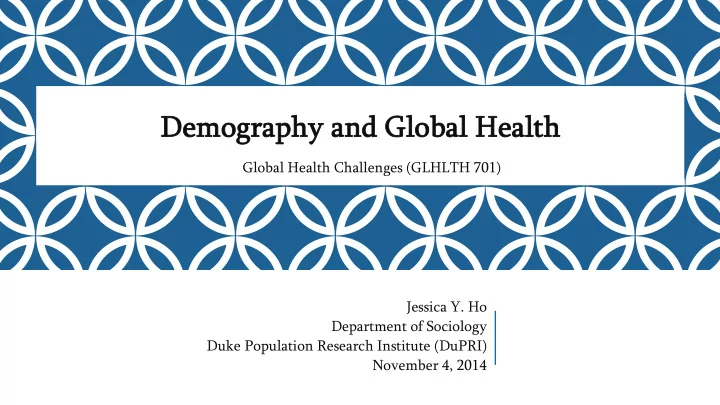

De Demo mograp raphy hy and and Glo lobal al Heal alth Global Health Challenges (GLHLTH 701) Jessica Y. Ho Department of Sociology Duke Population Research Institute (DuPRI) November 4, 2014
Demography 1) Mortality 2) Fertility 3) Migration 2
Demography 1. Size of populations 2. Population growth rate 3. Population composition o Age o Sex ex o Education o Race/ethnicity o Urban/rural o Employment o Marital status o … 3
Part I: World Population Size and Growth Historical population growth Current and future population size and growth o World o Regions o Countries Determinants of population size and growth o Mortality trends o Fertility trends 4
13 13 13 12 12 13 14 30 130 1800 1800 Source: Carl Haub, Population Reference Bureau 2010; U.N. Population Division (UNPD) 2011 5
Source: Carl Haub, Population Reference Bureau 2010; U.N. Population Division (UNPD) 2011 6
The Demographic Transition 7
Mortality Declines & Life Expectancy Gains Deve velope loped Countr trie ies (~1 ~1750 750-1930) 1930) 1760-1880: Gradual improvements in living standards and nutrition, smallpox inoculation, public health measures (quarantine) 1880-1930: Public health measures (filtering and chlorinating water, building sewage systems, and pasteurizing milk), personal health practices (hand washing, safer food preparation, boiling and sterilizing milk bottles, and quarantining and isolating sick family members), and improvements in living standards and nutrition 1930-present: Sulfa drugs, penicillin, treatments for cardiovascular disease, behavioral change Deve velopi loping ng Countri ntries es (~1 ~194 945-pres present) ent) Antimalarial campaigns, antibiotics, oral rehydration therapy for diarrheal diseases Large-scale child immunization programs: smallpox, polio, and measles Public health infrastructure (sanitation and water supply) 8
Source: Wilmoth 2000 9
Trends in Life Expectancy at Birth for Major World Regions, 1950 and 2010 10
Source: Population Reference Bureau 2014 11
Source: Lee 2003 12
Fertility Declines 13
Source: Guinane 2011 14
Total Fertility Rate by Region, 1950-2010 Source: UN 2013 15
Factors Contributing to Fertility Declines Industrialization and urbanization Shift towards individualism and self-fulfillment Declines in infant mortality Quantity-quality tradeoff Changes in the benefits to childbearing (child labor laws, public social insurance systems, urbanization) Family planning programs Diffusion of information and new social norms about birth control Rises in educational attainment and female labor force participation 16
17
Highest and Lowest Total Fertility Rates in 2013 and 1970 Source: PRB 2014 18
19
20
Changes in Age Structure by Region 21 Source: Population Reference Bureau 2014
Nigeria Chile Denmark India UAE Japan 22 Source: http://populationpyramid.net/
Source: Haub and Gribble 2011 23
Part II: Challenges Population size and growth/decline Urbanization Mortality and life expectancy Fertility Age structure International migration 24
25
Source: Lam 2011 26
Source: Lam 2011 27
Source: Population Reference Bureau 2014 28
29
30
Urbanization CONS PROS Poverty and urban slums Technological innovation Environmental degradation Concentration of labor Conflict Economic growth Congestion Rapid diffusion of information Sanitation and infrastructure Efficiency/productivity gains Rapid spread of communicable diseases Higher incomes and standards of living 31
Life Expectancy and Mortality Source: Reardon 2011 32
Life Expectancy and Mortality Nutrition and epidemiological transitions o Dual burden of disease o Obesity Smoking Health care system mismatches Living arrangements and old-age support Reverse transitions o HIV/AIDS o Russia and former Soviet countries o “New epidemics”: M/XDR -TB, Ebola, SARS, (avian) influenza 33
Fertility Potential consequences of high fertility: o Maternal and child health o Education o Female labor force participation o Economic growth Unmet need for family planning (intended vs. unintended births or desired vs. attained family size) o Access to and cost of contraception o Social barriers to contraceptive use o Status of women 34
Source: Bongaarts and Sinding 2011 35
Fertility Skewed sex ratios and son preference “Lowest low” fertility Source: Goldstein 2009; PRB 2014 36
Age Structure Youth bulge o Jobs and education o Underemployment o Instability, conflict, and violence Tend to be: o Low- and lower-middle- income countries o Countries in Africa and the Source: International Data Base, U.S. Census Bureau Middle East, as well as parts of South and Southeast Asia 37
Ag Age Distributi tribution on of Italy, y, 2014 4 and 2050 0 (proj oject ected) ed) Age Structure Population aging: a shift in the age distribution of a population towards older ages 38 Source: International Data Base, U.S. Census Bureau
Population Aging The dominant demographic trend of the 21 st century o Aging of the baby boomers o Societies are considered relatively old when the % aged 65+ > 8- 10% o % U.S. population aged 65+ in 1900 – 4.1% 2000 – 12.6% 2030 – 20.0% (projected) 39
Population Pyramids of More Developed Countries, 2010 and 2050 (projected) 40 Source: United Nations 2012
Challenges for Public Health & Economic Development Strains on health care system o Prevalence of disability, frailty, and chronic disease expected to rise Rising health care costs and bankruptcy of programs (e.g., Medicare) Pressure on social security programs and pension programs o Rising costs and sustainability concerns Shrinking and aging labor force o Labor shortages, lower productivity, effects on GDP and economic growth Health and well-being of the elderly o “Feminization” of aging o Rise in older people living alone o Poverty 41
42 Source: Bongaarts 2004
Suggested Measures Increase fertility Increase immigration Increase labor force participation Raise the age at retirement Reduce public pension benefits 43
Global Migration Flows 44
Source: http://www.global-migration.info/ 45
International Migration Process o National borders (South America/Mexico/U.S., North Africa/Greece/Italy) Destination o Assimilation, incorporation (residential segregation, discrimination) o Worker exploitation (World Cup) o Political and economic impacts (voting constituencies) Sending o Brain drains o Remittances 46
Recommend
More recommend